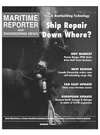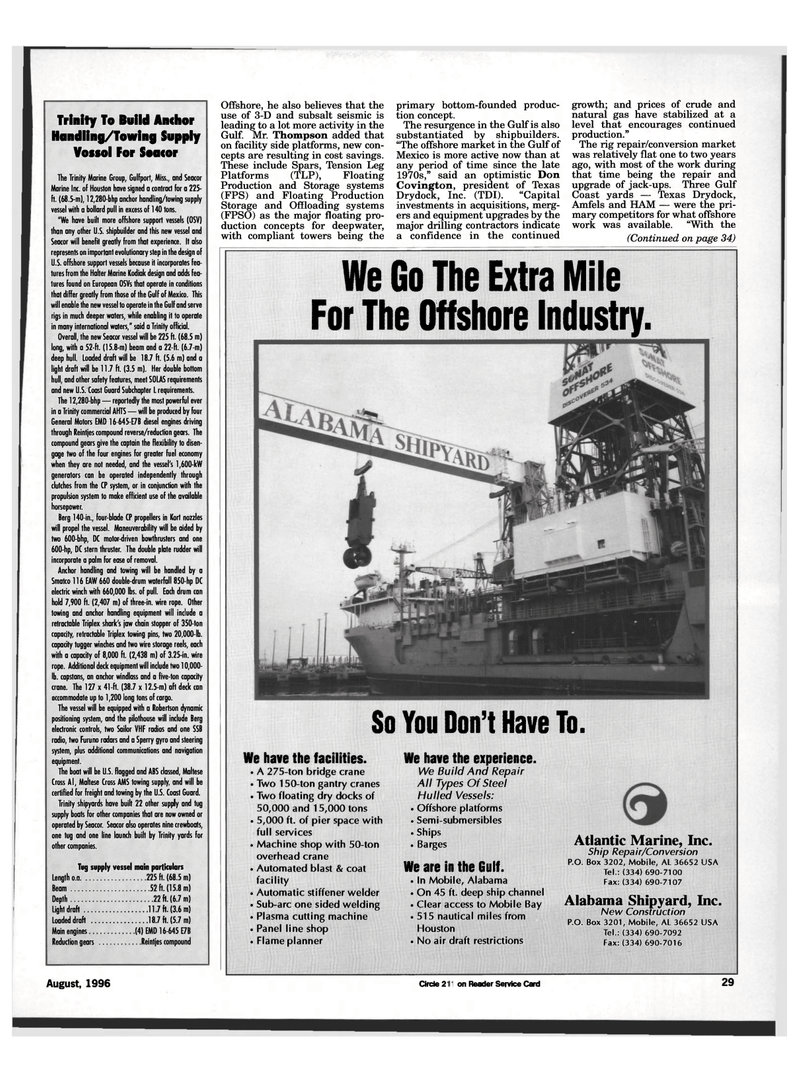
Page 27: of Maritime Reporter Magazine (August 1996)
Read this page in Pdf, Flash or Html5 edition of August 1996 Maritime Reporter Magazine
Trinity To Build Anchor
Handling/Towing Supply
Vossol lor Seacor
The Trinity Marine Group, Gulfport, Miss., and Seacor
Marine Inc. of Houston have signed a contract for a 225- ft. (68.5-m), 12,280-bhp anchor handling/towing supply vessel with a bollard pull in excess of 140 tons. "We have built more offshore support vessels (OSV) than any other U.S. shipbuilder and this new vessel and
Seacor will benefit greatly from that experience. It also represents on important evolutionary step in the design of
U.S. offshore support vessels because it incorporates fea- tures from the Halter Marine Kodiak design and adds fea- tures found on European OSVs that operate in conditions that differ greatly from those of the Gulf of Mexico. This will enable the new vessel to operate in the Gulf and serve rigs in much deeper waters, while enabling it to operate in many international waters," said a Trinity official.
Overall, the new Seacor vessel will be 225 ft. (68.5 m) long, with a 52-ft. (15.8-m) beam and a 22-ft. (6.7-m) deep hull. Loaded draft will be 18.7 ft. (5.6 m) and a light draft will be 11.7 ft. (3.5 m). Her double bottom hull, and other safety features, meet SOLAS requirements and new U.S. Coast Guard Subchapter L requirements.
The 12,280-bhp — reportedly the most powerful ever in a Trinity commercial AHTS — will be produced by four
General Motors EMD 16-645-E7B diesel engines driving through Reintjes compound reverse/reduction gears. The compound gears give the captain the flexibility to disen- gage two of the four engines for greater fuel economy when they are not needed, and the vessel's 1,600-kW generators can be operated independently through clutches from the CP system, or in conjunction with the propulsion system to make efficient use of the available horsepower.
Berg 140-in., four-blade CP propellers in Kort nozzles will propel the vessel. Maneuverability will be aided by two 600-bhp, DC motor-driven bowthrusters and one 600-hp, DC stern thruster. The double plate rudder will incorporate a palm for ease of removal.
Anchor handling and towing will be handled by a
Smatco 116 EAW 660 double-drum waterfall 850-hp DC electric winch with 660,000 lbs. of pull. Each drum can hold 7,900 ft. (2,407 m) of three-in. wire rope. Other towing and anchor handling equipment will include a retractable Triplex shark's jaw chain stopper of 350-ton capacity, retractable Triplex towing pins, two 20,000-lb. capacity tugger winches and two wire storage reels, each with a capacity of 8,000 ft. (2,438 m) of 3.25-in. wire rope. Additional deck equipment will include two 10,000-
Ib. capstans, an anchor windlass and a five-ton capacity crane. The 127 x 41-ft. (38.7 x 12.5-m) aft deck can accommodate up to 1,200 long tons of cargo.
The vessel will be equipped with a Robertson dynamic positioning system, and the pilothouse will include Berg electronic controls, two Sailor VHF radios and one SSB radio, two Furuno radars and a Sperry gyro and steering system, plus additional communications and navigation equipment.
The boat will be U.S. flagged and ABS classed, Maltese
Cross Al, Maltese Cross AMS towing supply, and will be certified for freight and towing by the U.S. Coast Guard.
Trinity shipyards have built 22 other supply and tug supply boats for other companies that are now owned or operated by Seacor. Seacor also operates nine crewboats, one tug and one line launch built by Trinity yards for other companies.
Tug supply vessel main particulars
Length o.a 225 ft. (68.5 m)
Beam 52 ft. (15.8 m)
Depth 22 ft. (6.7 m)
Light draft 11.7 ft. (3.6 m)
Loaded draft 18.7 ft. (5.7 m)
Main engines (4) EMD 16-645 E7B
Reduction gears Reintjes compound
Offshore, he also believes that the use of 3-D and subsalt seismic is leading to a lot more activity in the
Gulf. Mr. Thompson added that on facility side platforms, new con- cepts are resulting in cost savings.
These include Spars, Tension Leg
Platforms (TLP), Floating
Production and Storage systems (FPS) and Floating Production
Storage and Offloading systems (FPSO) as the major floating pro- duction concepts for deepwater, with compliant towers being the primary bottom-founded produc- tion concept.
The resurgence in the Gulf is also substantiated by shipbuilders. "The offshore market in the Gulf of
Mexico is more active now than at any period of time since the late 1970s," said an optimistic Don
Covington, president of Texas
Drydock, Inc. (TDI). "Capital investments in acquisitions, merg- ers and equipment upgrades by the major drilling contractors indicate a confidence in the continued growth; and prices of crude and natural gas have stabilized at a level that encourages continued production."
The rig repair/conversion market was relatively flat one to two years ago, with most of the work during that time being the repair and upgrade of jack-ups. Three Gulf
Coast yards — Texas Drydock,
Amfels and HAM — were the pri- mary competitors for what offshore work was available. "With the (Continued on page 34)
We have the facilities. • A 275-ton bridge crane • Two 150-ton gantry cranes • Two floating dry docks of 50,000 and 15,000 tons • 5,000 ft. of pier space with full services • Machine shop with 50-ton overhead crane • Automated blast & coat facility • Automatic stiffener welder • Sub-arc one sided welding • Plasma cutting machine • Panel line shop • Flame planner
We have the experience.
We Build And Repair
All Types Of Steel
Hulled Vessels: • Offshore platforms . Semi-submersibles • Ships • Barges
We are in the Gulf. • In Mobile, Alabama • On 45 ft. deep ship channel • Clear access to Mobile Bay • 515 nautical miles from
Houston • No air draft restrictions
Atlantic Marine, Inc.
Ship Repair/Conversion
P.O. Box 3202, Mobile, AL 36652 USA
Tel.: (334) 690-7100
Fax: (334) 690-7107
Alabama Shipyard, Inc.
New Construction
P.O. Box 3201, Mobile, AL 36652 USA
Tel.: (334) 690-7092
Fax: (334) 690-7016
We Go The Extra Mile
For The Offshore Industry.
So You Don't Have To.
August, 1996 Circle 287 on Reader Service Card 29

 26
26

 28
28
